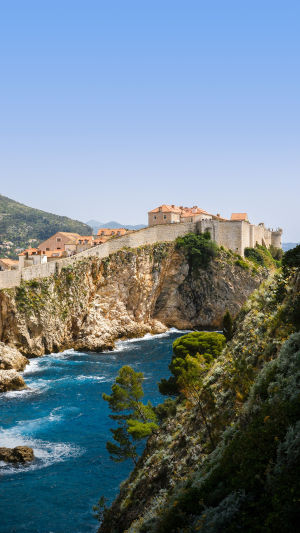Split, Croatia’s second-largest city, is a mesmerizing blend of ancient history and vibrant coastal beauty. With its stunning location along the Adriatic Sea and a fascinating blend of old-world charm and modern energy.
Split is a perfect destination for travelers seeking both adventure and relaxation. For Lykkers planning to explore this enchanting city, here is a comprehensive guide to ensure you make the most of your visit.
<h3>Getting to Split</h3>
<b>Split is well-connected to major European cities, and getting there is convenient</b>:
<b>By Air</b>: Split International Airport is located approximately 24 kilometers from the city center. Regular flights operate from key cities across Europe, with ticket prices ranging from €50 to €150 depending on the season. Upon arrival, a shuttle bus service is available, costing around €5-7, or you can take a taxi for approximately €35-40.
<b>By Ferry</b>: If you’re coming from another part of Croatia or nearby countries, ferries are an excellent way to arrive in Split. Regular ferry services run from islands like Hvar and Brač, as well as international routes from Italy. Ferry prices range from €20 to €50.
<b>By Train or Bus</b>: Split’s main bus and train stations are located near the city center, offering easy access to domestic and international travelers. Bus tickets from nearby cities such as Dubrovnik or Zagreb range from €10 to €25.
<h3>Entry and Visiting Information</h3>
Split’s historic center, particularly the famous Diocletian's Palace, is free to explore on foot. The entire area is open to visitors year-round, and while there is no entry fee for walking through the streets and alleys of this UNESCO World Heritage Site, specific attractions within the palace grounds may require a ticket.
<b>For example</b>:
<b>Diocletian's Cellars</b>: Entry fee is around €7, and it’s open daily from 8:00 AM to 6:00 PM.
<b>Cathedral of Saint Domnius Bell Tower</b>: A climb up the tower offers panoramic views of Split for around €5, and it’s open from 9:00 AM to 7:00 PM during the summer months.
If you're interested in guided tours, expect prices to range from €15 to €30 for a comprehensive walking tour of Split, including insights into its fascinating history and architecture.
<h3>Activities and Attractions</h3>
<b>Strolling the Riva Promenade</b>: The Riva is Split’s waterfront promenade, a vibrant place perfect for a relaxing walk along the sea. Lined with cafés and restaurants, it’s a great spot to enjoy the ocean breeze or people-watch. It's free to access and is bustling from early morning until late in the evening.
<b>Explore Marjan Hill</b>: For Lykkers who love nature, a hike up Marjan Hill offers incredible views of the city and surrounding islands. There are several hiking and biking trails, making it a fantastic place for outdoor activities. The best part? It’s free and open 24/7, making it ideal for early morning or sunset visits.
<b>Ferry to Nearby Islands</b>: Split is the perfect jumping-off point for exploring Croatia’s famous islands like Hvar, Brač, and Šolta. Ferries depart regularly from the harbor, and prices range from €5 to €20, depending on the destination. These islands offer pristine beaches, crystal-clear waters, and charming towns to explore.
<b>Beaches</b>: Split has some excellent beaches just a short walk or bus ride from the city center. The most popular is Bačvice Beach, known for its sandy shore and lively atmosphere. Other notable beaches include Kasjuni Beach, a more secluded spot perfect for those seeking a quieter escape.
<h3>Where to Eat</h3>
Split offers a delightful mix of traditional Croatian cuisine and modern international options. For an authentic taste of local seafood, check out Konoba Marjan, where dishes like fresh grilled fish or octopus salad cost around €15-25. If you're in the mood for something light and Mediterranean, Villa Spiza is a cozy restaurant with excellent vegetarian and seafood options for €10-20.
For a more casual dining experience, head to the Green Market near the city center, where you can sample fresh fruits, cheeses, and baked goods. Prices here are very reasonable, and it’s an excellent place to try local flavors on a budget.
<h3>Fun Facts About Split</h3>
<b>Diocletian’s Palace</b>: Built in the 4th century by the Roman Emperor Diocletian, the palace is a stunning blend of Roman architecture and medieval fortifications. It’s not only a historical site but also home to modern shops, cafés, and residences.
<b>Film Location</b>: Split’s ancient architecture has made it a popular filming location for several TV shows and films, including scenes from the globally popular series Game of Thrones.
<b>The Split Green Market</b>: Known as Pazar, this local market has been around for centuries and is a favorite among both locals and tourists for its fresh produce, seafood, and homemade goods.
<h3>Best Time to Visit</h3>
The best time to visit Split is during the late spring (May to June) or early autumn (September to October), when the weather is warm but the tourist crowds are thinner. Summer months (July and August) can be quite busy, but it’s also when the city is alive with festivals and events, including the Split Summer Festival, which showcases music, theater, and cultural performances.
<h3>Final remarks</h3>
Split, Croatia, is a city that offers a perfect balance between historical exploration and coastal relaxation. Whether you’re wandering through Diocletian's Palace, hiking Marjan Hill, or lounging on one of its beautiful beaches, Split provides an unforgettable experience. For Lykkers looking to immerse themselves in the magic of the Adriatic coast, this coastal gem is a must-visit destination.





